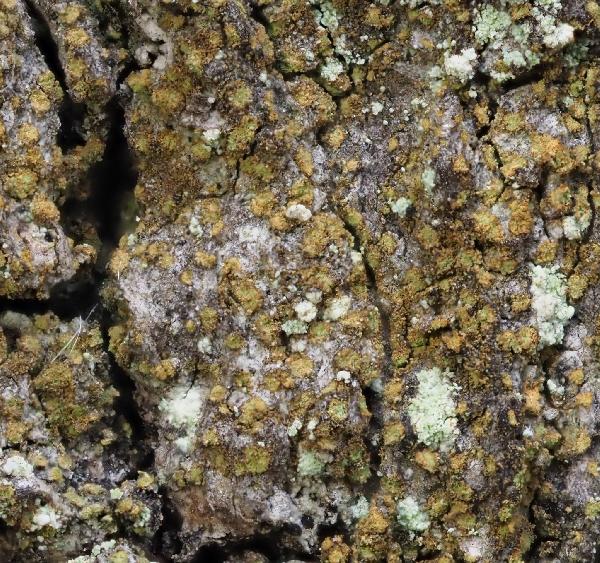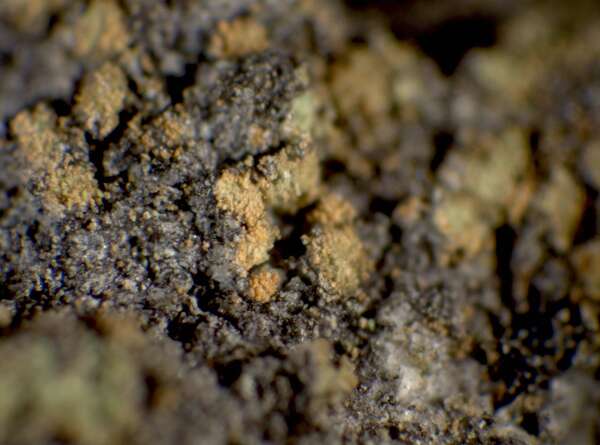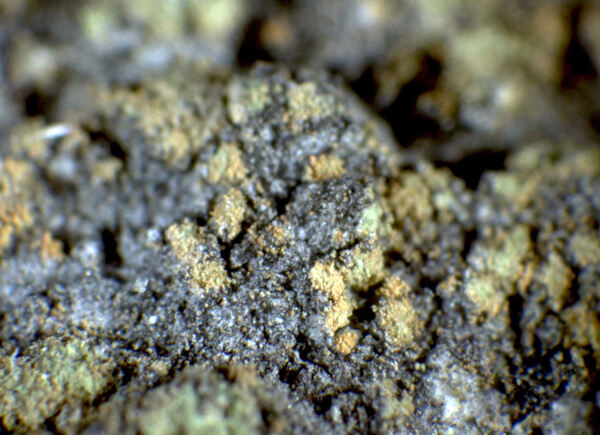Lendemeriella lucifuga (G. Thor) S.Y. Kondr.
in Kondratyuk & al., Acta Bot. Hung., 62, 1-2: 121, 2020. Basionym: Caloplaca lucifuga G. Thor - Lichenologist, 20: 175, 1988.
Synonyms:
Description: Thallus crustose, endosubstratic or thinly episubstratic, inconspicuous or visible as a thin grey film with scattered small warts. Soralia numerous, 0.15-0.35 mm in diam., breaking up from the warts, pale yellow, yellowish grey to dirty orange-brown (greenish in shade-forms), at first well-delimited, but sometimes confluent, initially flat, then often convex. Soredia granular or farinose 17-24 μm in diam. Apothecia unknown. Photobiont chlorococcoid, the cells 7-14 μm diam., arranged in clusters. Spot tests: thallus K- or rarely K+ faintly yellow, C-, KC-, P-; soralia K+ violet-red or rarely K-(anthraquinones may be absent in green soralia from shaded situations). Chemistry: anthraquinones in the soredia (parietin and fallacinal).
Growth form: Crustose
Photobiont: green algae other than Trentepohlia
Reproductive strategy: mainly asexual, by soredia, or soredia-like structures (e.g. blastidia)
In underhangs rarely wetted by rain
Commonnes-rarity: (info)
Alpine belt: absent
Subalpine belt: absent
Montane belt: absent
Dry submediterranean belt: extremely rare
Humid submediterranean belt: very rare
Padanian area: absent
pH of the substrata:
1 2 3 4 5
Solar irradiation:
1 2 3 4 5
Aridity:
1 2 3 4 5
Eutrophication:
1 2 3 4 5
Poleotolerance:
0 1 2 3
Altitudinal distribution:
1 2 3 4 5 6
Rarity
absent
extremely rare
very rare
rare
rather rare
rather common
common
very common
extremely common
Loading data...
Occurrence data
Predictive map
Growth form: Crustose
Photobiont: green algae other than Trentepohlia
Reproductive strategy: mainly asexual, by soredia, or soredia-like structures (e.g. blastidia)
In underhangs rarely wetted by rain
Commonnes-rarity: (info)
Alpine belt: absent
Subalpine belt: absent
Montane belt: absent
Dry submediterranean belt: extremely rare
Humid submediterranean belt: very rare
Padanian area: absent
pH of the substrata:
| 1 | 2 | 3 | 4 | 5 |
Solar irradiation:
| 1 | 2 | 3 | 4 | 5 |
Aridity:
| 1 | 2 | 3 | 4 | 5 |
Eutrophication:
| 1 | 2 | 3 | 4 | 5 |
Poleotolerance:
| 0 | 1 | 2 | 3 |
Altitudinal distribution:
| 1 | 2 | 3 | 4 | 5 | 6 |
Rarity
absent
extremely rare
very rare
rare
rather rare
rather common
common
very common
extremely common
Loading data...
Occurrence data
Predictive map









